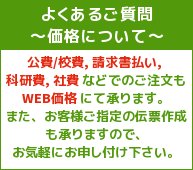Environmental Science
◆JpGU2025 セール開催中!:2025年6月30日(月)ご注文分まで
※上記表示の販売価格は割引適用後の価格です 出版済み 3-5週間でお届けいたします。 Active Learning Laboratories and Applied Problem Sets Author: Wagner, Travis P. (University of Southern Maine) / Sanford, Robert M. (University of Southern Maine) Publisher: WILEY ISBN: 9781119462590 Cover: PAPERBACK Date: 2024年09月 DESCRIPTION Historically viewed as a sub-discipline of biology or ecology, environmental science has quickly grown into its own interdisciplinary field; grounded in natural sciences with branches in technology and the social science, today’s environmental science seeks to understand the human impacts on the Earth and develop solutions that incorporate economic, ethical, planning, and policy thinking. This lab manual incorporates the field’s broad variety of perspectives and disciplines to provide a comprehensive introduction to the everyday practice of environmental science. Hands-on laboratory activities incorporate practical techniques, analysis, and written communication in order to mimic the real-world workflow of an environmental scientist. This updated edition includes a renewed focus on problem solving, and offers more balanced coverage of the field’s diverse topics of interest including air pollution, urban ecology, solid waste, energy consumption, soil identification, water quality assessment, and more, with a clear emphasis on the scientific method. While labs focus on the individual, readers are encouraged to extrapolate to assess effects on their campus, community, state, country, and the world. TABLE OF CONTENTS PART 1 General Information 1 Laboratory Health and Safety Procedures 2 Sample Student Lab Report 10 PART 2 Labs 15 LAB 1 Evaluating Sustainable Practices 16 LAB 2 Analyzing and Interpreting Environmental Data 23 LAB 3 Environmental Science in the Media 32 LAB 4 Sustainability and Business 35 LAB 5 Environmental Site Inspection 38 LAB 6 Urban Ecosystems 43 LAB 7 Experimental Design: Range of Tolerance 50 LAB 8 Experimental Design: Environmental Contamination 56 LAB 9 Landscaping for Energy Conservation 63 LAB 10 Alternative Energy: Wind Power 68 LAB 11 Global Climate Change and Automobiles 76 LAB 12 Household Contribution to Climate Change 81 LAB 13 Hydrology and Groundwater Pollution 86 LAB 14 Stormwater Generation and Management 93 LAB 15 Applying the Scientific Method: Dowsing for Water 100 LAB 16 Aquatic Species Diversity and Water Quality 104 LAB 17 Environmental Forensics 108 LAB 18 Actual/Virtual Field Trip: Municipal Wastewater Treatment Plant 114 LAB 19 Actual/Virtual Field Trip: Wetlands and Their Ecosystem Functions 118 LAB 20 Actual/Virtual Field Trip: Water Treatment Plant 121 LAB 21 Soil Characterization 125 LAB 22 Climate Change and Sea Level Rise 131 LAB 23 Reducing the Generation of Solid Waste 138 LAB 24 Reducing Campus Food Waste 145 LAB 25 Compost Facility Planning and Siting 151 LAB 26 Actual/Virtual Field Trip: Solid Waste Management 159 LAB 27 Testing the Toxicity of Chemicals 163 LAB 28 Environmental Risk Perception 170 LAB 29 Human Survivorship Changes 174 LAB 30 Indoor Air Quality Inspection 179 LAB 31 Lung Power 184 PART 3 Applied Problem Sets 187 PROBLEM SET 1 The Scientific Method: Observation and Hypotheses 188 PROBLEM SET 2 The Scientific Method: Results and Discussion 191 PROBLEM SET 3 Quantification of Environmental Problems 196 PROBLEM SET 4 Ecosystem Diagram 201 PROBLEM SET 5 Biogeochemical Concept Map 202 PROBLEM SET 6 Global Climate Change, CO2, and You 204 PROBLEM SET 7 Recognizing Human Impacts 208 PROBLEM SET 8 Carbon Footprints and Sustainability 211 PROBLEM SET 9 Oil Consumption and Future Availability 213 PROBLEM SET 10 Water Quality and Consumer Choice 215 PROBLEM SET 11 Local Environmental Risk 218 PROBLEM SET 12 Society and Waste 220 PROBLEM SET 13 Environmental Modeling 223 PROBLEM SET 14 Environmental Awareness and Ecological Identity 227 PROBLEM SET 15 Trophic Levels and a Tidal Marsh 229 PROBLEM SET 16 Food Efficiency: The Breakfast Assessment 232 PROBLEM SET 17 Life-Cycle Assessment 235 PROBLEM SET 18 Understanding Pesticide Labels 238 PROBLEM SET 19 Review and Reflection 239 PART 4 Appendices 241 Glossary 242 The Metric System 248 Conversion Factors 249 Numerical Prefixes 250 About the Authors 251

|
||||||||||||||||||||||||||||||||||||||||||||||||
























